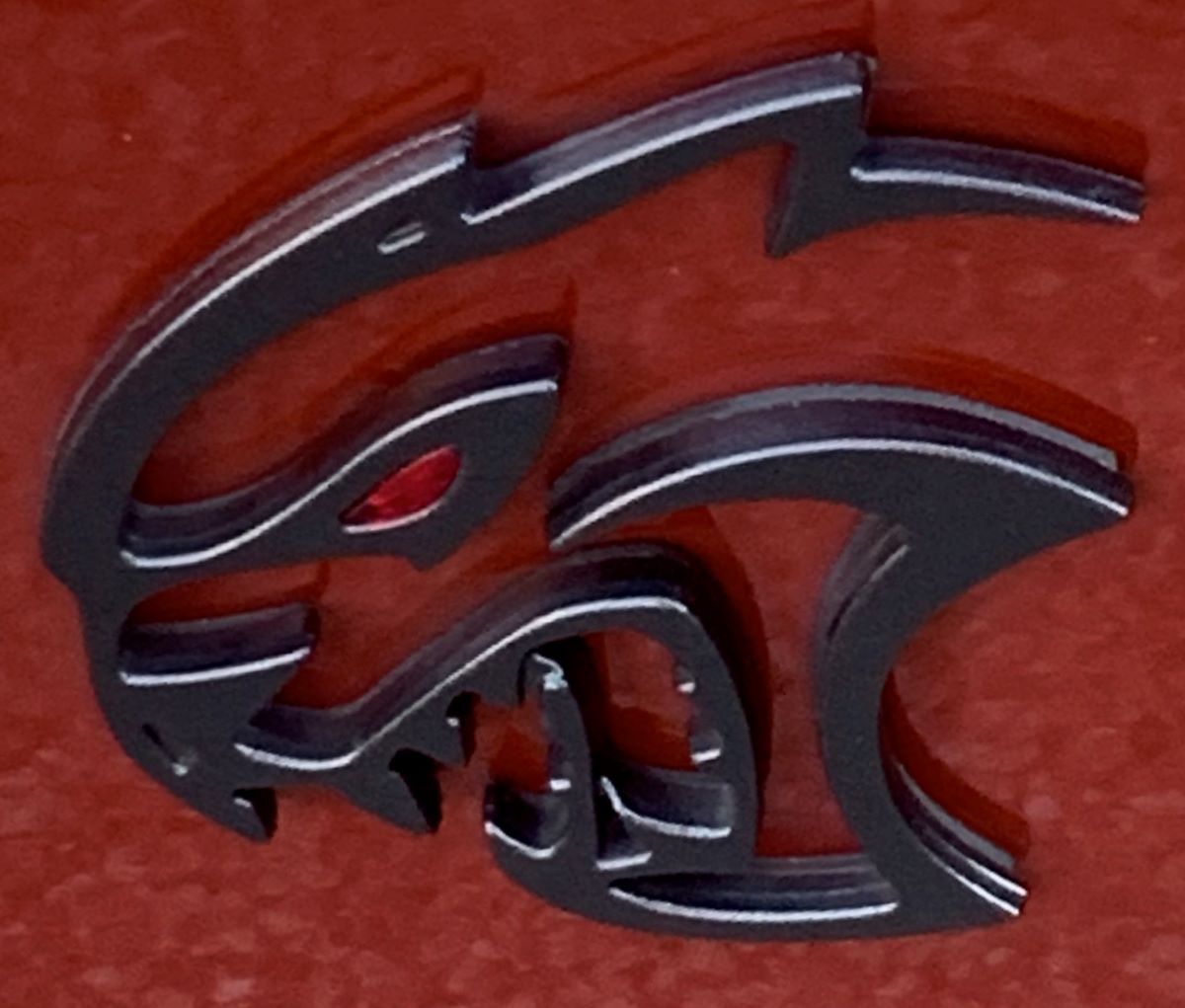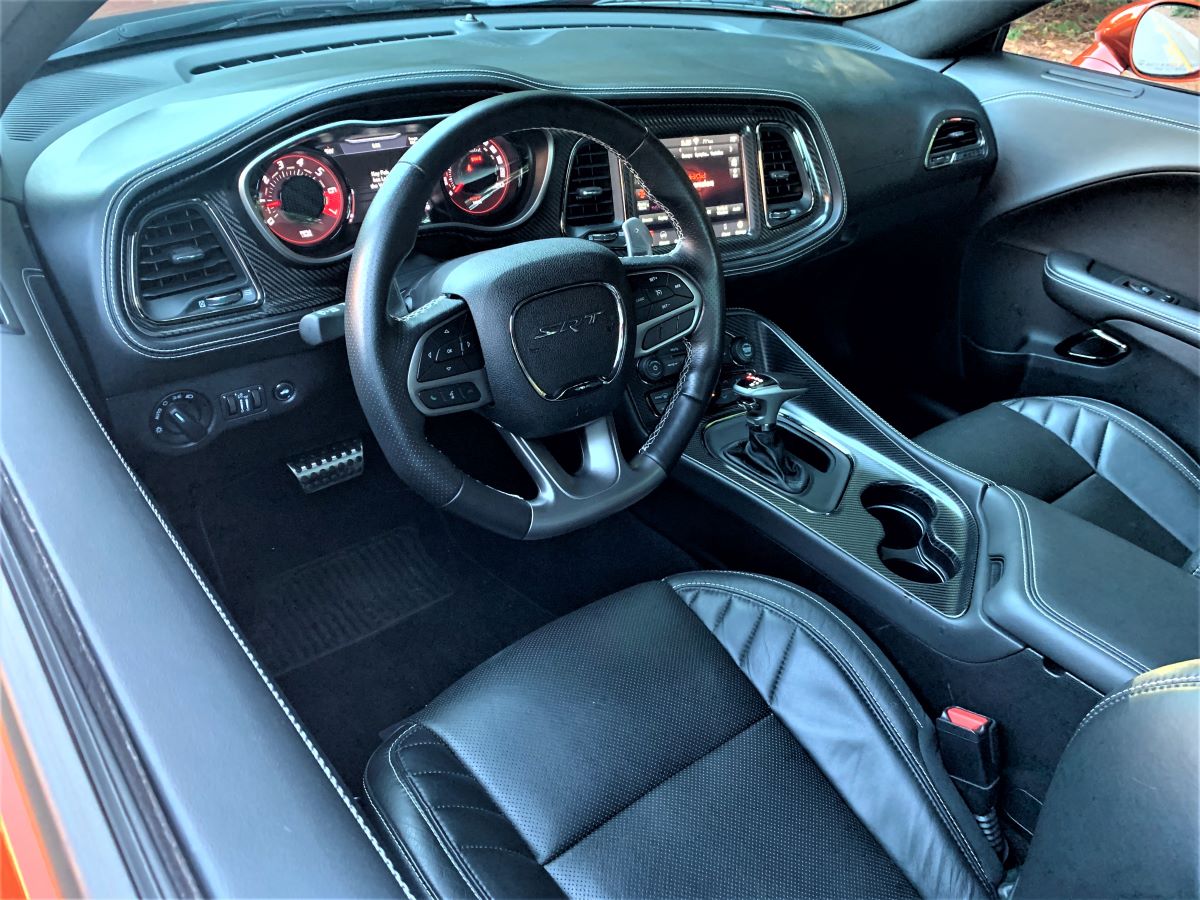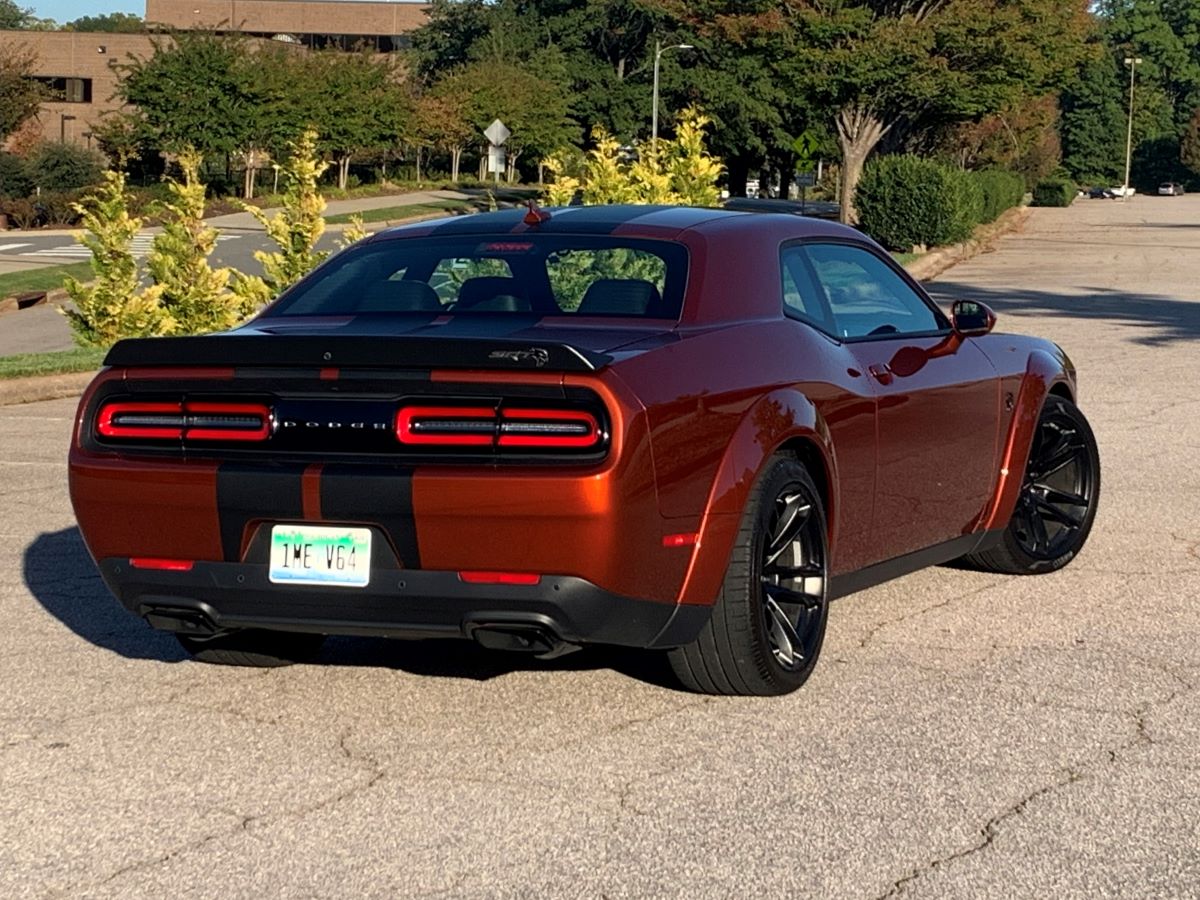On the road with the hottest Hellcat of all.
The Dodge Challenger is a mid- to large-size sport coupe, a throwback to models popular in the 1960s and 1970s. The current model, introduced in 2008, has undergone numerous tech and engineering iteration since, but otherwise remains largely the same over its current run.
The Challenger competes in a narrow segment with the Chevrolet Camaro and Ford Mustang. Unlike the other two with available convertibles, this one makes do with its traditional hardtop design.
2020 Dodge Challenger SRT Hellcat Redeye Widebody Review

Dodge offers the 2020 Challenger in multiple trims and additional permutations based chiefly on the drivetrain or powertrain available. The standard SXT starts at $28,095, while the Hellcat Redeye Widebody costs $78,695. The top-trim models also incur a $2,100 gas guzzler tax. All models are assessed with a $1,495 destination charge.
Our test model had one of the longest model names we’ve seen thus far – “2020 Dodge Challenger SRT Hellcat Redeye Widebody”. The model year, brand, and model name need no further explanation, but the remaining four descriptors do.
First, we have SRT – Street and Racing Technology. This is Dodge’s performance arm, which is responsible for developing the performance versions of the Charger, Challenger, and Durango models.
Second, we have Hellcat. Although that name hardly needs an introduction, it represents models motivated by the most powerful of three Hemi V8 engines. The current performance range starts at 717 and tops out at 807 horsepower. It’s that upper range that represents the Redeye sobriquet: 797 or 807 horsepower.
The final designation, Widebody, represents wider fenders, body skirting and enhanced wheel lips that increase the Challenger’s width. Here, the Challenger is no wider between the left and right wheels, but its overhangs are more pronounced.
With a starting price of $78, 695, the Redeye already carries a $50,000 price premium over the base model. Add in the required gas guzzler tax ($2,100) and the destination charge ($1,495), and the cost rises to $82,290.
But there are upgrades available too in the form of various packages. These include a Plus Package ($2,095), Driver Convenience Group ($1,295), Technology Group ($1,295), Laguna Leather Package ($1,795), Alcantara Appearance Package ($1,795), and a Carbon and Suede Interior Package ($1,595). There is also a Rear Seat Delete option that replaces the rear seat with a cargo net.
Our final price came in at $92,245, but that’s before discounting kicks in that typically shaves thousands off the final cost. As of this writing, the discounts approached $8,000.
Exterior

The Challenger’s silhouette represents the familiar “coke bottle” design from this model’s earliest years and modernized for the twenty-first century. Dodge kept enough of the original’s design elements to make a handsome tribute to the earlier model, including the oval headlamps, high profile, and the defining “fuel” label over the fuel door.

New elements include LED lights ringing the headlamps, contemporary sport wheels set within all-season performance tires, and track LED lighting, to name a few. Line the original and the current model side-by-side and the heritage cues becomes quite evident.
As for the Hellcat, Dodge includes numerous features that enhance performance and looks. Most noticeable is the aluminum dual-scoop hood, a design that supplies the Hellcat with “nostrils.” An SRT front fascia, conical cold-air intake, special 20-inch lightweight aluminum wheels, and red brake calipers are other noteworthy upgrades.
We’d be remiss if we left out three sources for cooling the Redeye: the two air catcher headlamps and an inlet located near the wheel liner. The air catchers are interesting as they replace what appears to be headlamps up front. Instead, holes allow air to flow through the engine compartment.
Dodge also gives the Redeye special badging unique to this trim. Look closely at the Hellcat insignia and direct your attention to where an eye would be. On other Hellcat models, there isn’t an eye. On this one, a red “eye” is present.
Interior

The Challenger seats five, but two is the ideal. The rear seat seems almost like an afterthought – access and egress are difficult. Moreover, if you sit in the back, you’ll find the legroom limited: just 33.1 inches are available.
That’s still better than some models, but it isn’t comfortable. Also, you’ll sit low and the sightlines are terrible. Certainly, it would be better to opt for the rear seat delete and call it a day.
We’re pleased with the Challenger’s fit and finish as well as the materials used. The interior is dark, well ordered, and not overrun by buttons and gadgets. Its as close to a throw-back design as Dodge dared go without leaving twenty-first century buyers in the dust.
The instrumentation is heritage oriented with huge dials for the tachometer and speedometer. The usual driver information center sits between the two and reveals a Hellcat Redeye logo on ignition. A flat-bottomed steering wheel and center console passenger hand grip are expected touches along with the aluminum pedals.
The front seats are comfortable, even a bit snug with generous bolstering. Most definitely Dodge designed this car with the driver and front passenger’s comfort in mind.
One of the Challenger’s strong suits is its big trunk, which measures 16.2 cubic feet. Compare that to the 13.5 cubic feet for the Mustang and the 9.1 cubic feet for the Camaro and the differences are quite stark.
See Also – 12 Things We LOVE About the Dodge Charger R/T Scat Pack
Safety
If you want forward collision warning and adaptive cruise control, these features are available on all other trims, but not on the Hellcat Redeye. We’re not sure why it’s this way, but it might have something to do with the grille design and the placement of sensors and cameras.
Choose the Driver Confidence Group and the Redeye gains blind-spot monitoring with rear cross-traffic detection. But you won’t find other features such as lane keep assist and lane departure warning, which are common in modern cars.
Technology

Fiat Chrysler’s Uconnect infotainment interface is one of our favorites. It’s easy to use with clear screens and large icons present. Some Challenger models have the standard 7-inch display, while others, including the Hellcat, have an 8.4-inch display.
Dodge bundles Uconnect with Bluetooth, Apple CarPlay and Android Auto smartphone compatibility, and two USB ports. The Hellcat adds navigation, although you might not use it much if you’re connected with your smartphone.
A six-speaker sound system is standard across the model line, although an Alpine system is in the Hellcat.
Better yet, if you spring for the audio group upgrade, you’ll gain an 18-speaker Harman Kardon audio system and that makes for a sweet sound experience!
Performance

The differences between the standard Hellcat and the Redeye yields a power boost of more than 10 percent with the latter. While the standard model makes 717 horsepower and 656 pound-feet of torque, the Redeye delivers 797 horsepower and 717 pound-feet of torque.
The power increase is due to yet another modification under the hood. Specifically, Dodge swaps out the 2.4-liter supercharger in the Hellcat for a 2.7-liter unit in the Redeye. Furthermore, boost increases from 11.6 PSI to 14.5 PSI, while the redline moves up to 6,400 RPM from 6,000 RPM.
But Dodge wasn’t done yet as the Redeye also benefits from stronger rods and pistons, an enhanced oil capability, and a pair of dual-stage oil pumps (up from the standard one). Other upgrades include an all-new performance hood, a mail-slot grille, and a cold-air intake fixed near the wheel liner.
Inasmuch as the power quotient increases here, Dodge gives customers an opportunity to bump performance to 807 horsepower by means of a Super Stock package. This upgrade not only increases power but it comes with a revised suspension system and grippier tires.
No, this trim doesn’t match the Hellcat Demon’s 848 horsepower, but it also doesn’t require aircraft fuel – premium grade will do. Anyway, the Demon with premium fuel was “only” rated at 808 horsepower for a barely noticeable increase over the Super Stock.

So, the big question related to the Challenger, specifically the Hellcat and entirely to the Redeye is this one: how fast is it?
For the 0-60 mph time, it comes in at a blistering 3.4 seconds. As for the quarter-mile, figure about 10.8 seconds at 131 mph. Yes, we did play with the first time, but not the second – you need a track to reach that lofty speed.
The way the Redeye behaves is nothing less than outstanding. What may slow you down is the shifting and squealing rear tires. More than once the tires shifted out from underneath us as full power moved to the rear wheels. This can be disconcerting to the novice or anyone unfamiliar with the raw power at hand. A tight grip of the steering wheel and easing up on the gas pedal will bring the Redeye under control.
Some of the most fun is procured by playing with the touchscreen display. Indeed, all the performance commands to help you get the most out of the Redeye are reachable by clicking “Apps” on the screen. From there, you’ll find various “race options,” including line lock, launch control, chiller, shift light, and race cooldown.
Electronic lock is a sought-after feature, something that engages the front brakes to hold the coupe steady while leaving the rear wheels free for a burnout. You may have seen videos of these antics and they are certainly a sight to behold. The noise and smoke generated is astounding – you don’t want to do this too much for the sake of the tires.

We prefer playing with launch control as this is a better way to gauge performance. This feature works by activating the system, holding the brake pedal in place with your left foot while pressing down on the gas pedal with your right foot. Once the engine hits a certain RPM (usually in about 10 seconds), then release the brake and enjoy head snap-back straight-line acceleration.
Two other features include the chiller and after-run chiller. The first one is tasked with diverting the air-conditioning refrigerant from the cabin to a chiller unit mounted by the low temperature circuit coolant pump.
After going through other processes, the coolant finally flows to the heat exchangers in the supercharger. In the Redeye, the chiller is optimized to lower the intake air temperature further for improved performance.
The second feature is what Dodge calls an “after-run chiller.” It’s designed to automatically kick on when the engine is shut off, keeping the cooling fan and low-temperature circuit coolant pump running to lower the supercharger air temperature. It’s on the panel where the driver can track the supercharger temperature.

We’re thoroughly impressed by what the Hellcat Redeye has to offer. Besides its heritage good looks, comfortable seats, and decent tech offerings, it simply is a very fast car. We found the steering weighty, but not tiresome, and the ride was comfortable. On the other hand, it doesn’t excel in cornering.
The Redeye is heavy – it weighs more than 4,400 pounds and it doesn’t feel light on its feet. In fact, it feels cumbersome at times, especially when navigating twisty roads. It isn’t anywhere as well planted as the Camaro or Mustang, and it certainly is not like any smaller model such as the Toyota GR Supra or the Nissan 370Z.
While most sport coupes of this generation do a far better job of handling twisty roads, the Challenger tends to rock back and forth slightly. If you’re cornering, the full weight of this vehicle becomes apparent if you don’t significantly reduce your speed.
Dodge offers all-wheel drive with the V6 model, but only rear-wheel drive with the V8s. The added weight of such a system would affect performance, although its handling advantage would assist with control. The Camaro and Mustang are about 500 pounds lighter and at least six inches shorter between the axles. Neither has all-wheel drive, but both have sophisticated suspension systems.

Most of our driving was local or by navigating the backroads of central North Carolina. We took one trip to Roxboro, a 90-mile circuitous route. We averaged 16.6 mpg across those miles, but finished about 1 mpg lower overall.
For this reason the Redeye is slapped with the EPA’s gas guzzler tax as the Redeye earns an estimated 13 mpg in the city, 21 mpg on the highway for a combined 16 mpg. Premium fuel is the rule; expect regular fill ups if the Redeye is also your daily driver.
Which Hellcat?

Our focus here is on the Redeye, but it isn’t the only Hellcat model. Indeed, start with the standard model and that’s all the Hellcat most drivers want. Quite easily, your price may approach $70,000, but that’s before discounting comes in.
The Redeye with or without the Super Stock Package brings in the extra performance, but it does so at a significant price premium. Indeed, the Hellcat Redeye Widebody represents a $17,600 upgrade bundle and that’s before another $10,000 in package options on our test model.
Doubtlessly, few people give price another thought when weighing the Redeye – they can afford the upgrade and they also value the performance edge provided. Judging by this vehicle’s reception at a local Cars and Coffee event, the Redeye is the frosting on the eye candy everyone wishes they had. And that, my friends, is enough.
2020 Dodge Challenger Specifications
| Dodge | 2020 Challenger |
|---|---|
| Segment | Sports coupe |
| Price Range | $28,095 to $78,695 (plus $2,100 gas guzzler tax) |
| Destination Charge | $1,495 |
| Engine No. 1 | 3.6-liter, V6 |
| Horsepower | 303 @ 6,350 rpm |
| Torque (lb.-ft.) | 268 @ 4,800 rpm |
| Transmission | 8-speed automatic |
| Engine No. 2 | 5.7-liter, V8 |
| Horsepower | 372/375 @ 5,200/5,150 |
| Torque (lb.-ft.) | 400/410 @ 4,400/4,300 rpm |
| Transmission | 8-speed automatic |
| Engine No. 3 | 6.4-liter, V8 |
| Horsepower | 485 @ 6,100 rpm |
| Torque (lb.-ft.) | 475 @ 4,100 rpm |
| Transmission | 8-speed automatic |
| Engine No. 4 | 6.2-liter, supercharged V8 or HO V8 |
| Horsepower | 717/797/807 @ 6,000/6,400 rpm |
| Torque (lb.-ft.) | 656/707 @ 4,800 rpm |
| Transmission | 8-speed automatic |
| Seating | 5 |
| Curb Weight (pounds) | 3,858 to 4,492 |
| Wheelbase (inches) | 116.0 |
| Length (inches) | 197.5, 197.9 |
| Width (inches) | 75.7, 78.3 |
| Height (inches) | 57.2 to 58.4 |
| Headroom (f,r…inches) | 39.3, 37.1 |
| Legroom (f,r…inches) | 42.0, 33.1 |
| Shoulder room (f,r…inches) | 58.5, 53.9 |
| Hip room (f,r…inches) | 55.3, 47.8 |
| Storage (cubic feet) | 16.2 |
| Gross vehicle weight (pounds) | NR |
| Towing (pounds) | 1,000 (V6 only) |
| Payload (pounds) | NR |
| Fuel | Regular (V6), Midgrade (5.7), Premium (others) |
| Fuel Tank (gallons) | 18.5 |
| EPA Fuel MPG (city/highway/combined) | 19/30/23 (V6); 13/21/16 (6.2) |
| Manufacturing Plant | Brampton, Ontario, Canada |
Data compiled by Tom Keegan. Specifications supplied by the manufacturer.
See Also – 2018 Dodge Charger SRT Hellcat Review
Photos copyright Auto Trends Magazine. All rights reserved.
- 2024 Mazda CX-50: A Compact SUV with Premium Aspirations - Apr 15, 2024
- 2024 Ford Mustang (Iconic Pony Car Evolves) - Apr 4, 2024
- 2024 Ford Maverick (Looks Like a Truck, Drives Like a Car) - Mar 28, 2024

